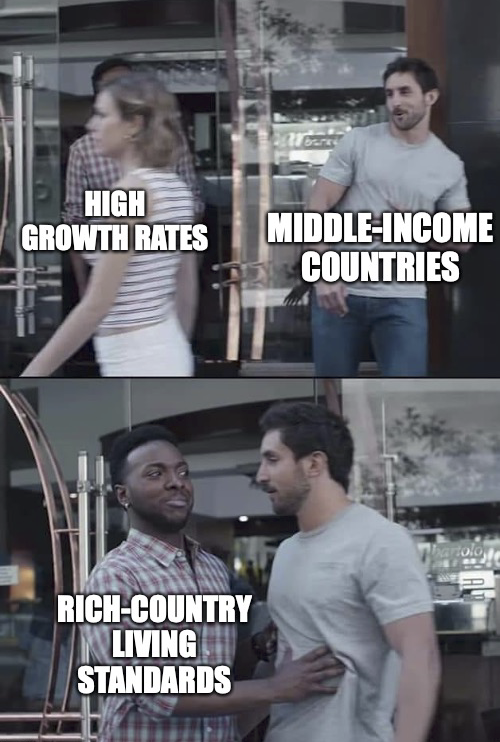Convergence and catch-up growth

Convergence
The prior section asserted that economic growth was stable over long periods of time, at least for developed economies. However, if you look back at those figures you’ll see that there were a lot of possible deviations. Countries like Japan, South Korea, and Germany all had very high growth rates for a while compared to the US or UK, before settling down. In countries like Nigeria and China, we see surges in the growth rate and collapses in the growth rate, but it isn’t obvious that they are headed towards stable growth.
We can explore those deviations in a little more detail, and see if we can come up with any regularities. The figure below is different than what you’ve seen before. Here, what is plotted is the 10-year growth rate against the level of GDP per capita at the beginning of that 10-year period. For example, when Japan had a log GDP per capita of 8.65, it had an annualized growth rate of 8.9% over the next ten years.
You can divide this figure in half, right at a value of log GDP per capita of about 8.5. To the right of that dividing line, there is a clear negative relationship of the growth rate and the level of GDP per capita. Given that economic growth pushes up the level of GDP per capita, by definition, this part of the figure works a little like a slide. If you get on the slide with a GDP per capita around 8.5, then the growth rate is around 6-8% per year, and GDP per capita rises rapidly. But as the living standard rises, you move to the right (down the slide), and the growth rate tends to be lower. Once you get to the bottom of the slide at around (log) GDP per capita between 10 and 11, near the US level, the growth rate drops to right around 1.8% per year.
The right-hand part of this figure is capturing what we saw in the prior section for Japan, Germany, and South Korea converging to the US. The tight overlap of the data from different countries here indicates that there is a consistent process at work in all these countries, and at least suggests that we could use a similar model of economic growth to explain what was going on in all of them.
We can use the right-hand side of this figure to establish one more stylized fact.
Differences in the growth rate of GDP per capita between developed economies appear to be temporary.
For relatively developed economies, those with log GDP per capita above 8.5, growth can be very high, but that appears to always dissipate. None of them are able to sustain growth of 6-8% per year for more than a decade or so. Eventually, as they get even richer, their growth rates decline towards the common 1.8% growth rate seen in places like the US and UK. Growth rates can differ across developed countries, but this appears to be a temporary phenomenon as a country catches up to the richest countries.
Non-convergence
Okay, that works for countries on the right-hand side of the figure above. But clearly everything to the left side of the figure isn’t converging to the rich-country growth rate of 1.8% or to high levels of GDP per capita. There is no systematic relationship between growth rates and the level of GDP per capita once log GDP per capita is below 8.5. It appears as if the growth rates in economies that are very poor tend to vary a lot, but that they do not systematically lead to convergence with rich countries.
Nigeria is a good example, as you can see that the growth rate bounced between -3% and 5% throughout its recent history, leaving log real GDP per capita hovering around 8 the whole time. But it was never able to jump on the slide like South Korea or Japan.
This is why China is a very interesting case. China was very poor for most of the 20th century, and had very low growth rates. Hover over the points in the southwest corner of the figure to see this. But as the 1980s began China was able to increase the growth rate and log GDP per capita. China has just recently hit the peak of the data in this curve, with log GDP per capita pushing past 8.5, and a high growth rate of around 8% per year. Based on past experience with Japan, South Korea, and Germany, it looks like China is about to jump on the slide. So we might predict that as China continues to get richer, its growth rate will slow down towards 1.8%. We don’t know for sure. This figure doesn’t predict the future, it only shows us what happened in the past. But it seems to indicate that if China were to continue growing at 8% per year, it would be historically unprecedented.
In terms of how we approach the study of economic growth, the division between right and left in the figure is quite important. This guideis focused on the explanation for the right-hand side of this figure, with the implied convergence over time. The regularity of the negative relationship between growth rates and GDP per capita will help us explain how economic growth works in already developed economies. Explaining what happens on the left-hand side of the figure, among relatively poor economies, and what does or does not allow them to make the jump to the right-hand side, is a fascinating question with far fewer solid answers. The study guide will touch some on how countries shift from left to right, but know that most of what we do focuses on relatively rich countries.